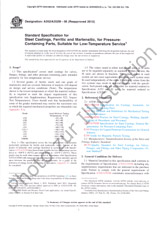Wir benötigen Ihre Einwilligung zur Verwendung der einzelnen Daten, damit Sie unter anderem Informationen zu Ihren Interessen einsehen können. Klicken Sie auf "OK", um Ihre Zustimmung zu erteilen.
ASTM F2028-17
Standard Test Methods for Dynamic Evaluation of Glenoid Loosening or Disassociation
Name übersetzen
NORM herausgegeben am 1.12.2017
Informationen über die Norm:
Bezeichnung normen: ASTM F2028-17
Ausgabedatum normen: 1.12.2017
SKU: NS-804694
Zahl der Seiten: 15
Gewicht ca.: 45 g (0.10 Pfund)
Land: Amerikanische technische Norm
Kategorie: Technische Normen ASTM
Kategorie - ähnliche Normen:
Die Annotation des Normtextes ASTM F2028-17 :
Keywords:
arthroplasty, glenoid, loosening, subluxation, total shoulder replacement, arthroplasty, disassociation, glenoid, subluxation, total shoulder replacement, arthroplasty, glenoid loosening, reverse total shoulder replacement, subluxation,, ICS Number Code 11.040.40 (Implants for surgery, prothetics and orthotics)
Ergänzende Informationen
| Significance and Use | ||||||
|
5.1 This test method is intended to investigate the resistance of a glenoid component to loosening. Glenoid loosening is the most common clinical complication in total shoulder arthroplasty (see X1.1). The method assumes that loosening occurs because of edge loading, often called the rocking-horse phenomenon. 5.2 This test method can be used both to detect potential problems and to compare design features. Factors affecting loosening performance include articular geometry, flange geometry, materials, fixation design, bone quality, and surgical technique. |
||||||
| 1. Scope | ||||||
|
1.1 These test methods measure how much a prosthetic anatomic glenoid component rocks or pivots following cyclic displacement of the humeral head to opposing glenoid rims (for example, superior-inferior or anterior-posterior). Motion is quantified by the tensile displacement opposite each loaded rim after dynamic rocking. Similarly, these test methods measure how much a prosthetic reverse glenoid component rocks or pivots following cyclic articulation with a mating humeral liner. Motion is quantified by the magnitude of displacement measured before and after cyclic loading. 1.2 The same setup can be used to test the locking mechanisms of modular glenoid components, for example, disassociation of both anatomic and reverse shoulder components. 1.3 These test methods cover shoulder replacement designs with monolithic or modular glenoid components for cemented fixation as well as reverse glenoid components for uncemented fixation. 1.4 The values stated in SI units are to be regarded as standard. No other units of measurement are included in this standard. 1.5 This standard does not purport to address all of the safety concerns, if any, associated with its use. It is the responsibility of the user of this standard to establish appropriate safety and health practices and determine the applicability of regulatory limitations prior to use. 1.6 This international standard was developed in accordance with internationally recognized principles on standardization established in the Decision on Principles for the Development of International Standards, Guides and Recommendations issued by the World Trade Organization Technical Barriers to Trade (TBT) Committee. |
||||||
| 2. Referenced Documents | ||||||
|
Empfehlungen:
Aktualisierung der technischen Normen
Wollen Sie sich sicher sein, dass Sie nur die gültigen technischen Normen verwenden?
Wir bieten Ihnen eine Lösung, die Ihnen eine Monatsübersicht über die Aktualität der von Ihnen angewandten Normen sicher stellt.
Brauchen Sie mehr Informationen? Sehen Sie sich diese Seite an.




 Cookies
Cookies
